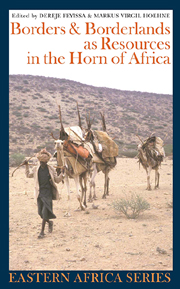Book contents
- Frontmatter
- Contents
- List of Maps, Tables & Charts
- Preface by Günther Schlee
- Editors' Preface
- Notes on Contributors
- List of Acronyms
- 1 State Borders & Borderlands as Resources
- 2 More State than the State?
- 3 Making Use of Kin beyond the International Border
- 4 The Tigrinnya-speakers across the Borders
- 5 Trans-Border Political Alliance in the Horn of Africa
- 6 People & Politics along & across the Somaliland-Puntland Border
- 7 The Ethiopian-British Somaliland Boundary
- 8 The Opportunistic Economies of the Kenya-Somali Borderland in Historical Perspective
- 9 Magendo & Survivalism
- 10 Can Boundaries not Border on One Another?
- 11 Conclusion
- Index
- EASTERN AFRICAN STUDIES
2 - More State than the State?
The Anywaa's Call for the Rigidification of the Ethio-Sudanese Border
Published online by Cambridge University Press: 05 April 2013
- Frontmatter
- Contents
- List of Maps, Tables & Charts
- Preface by Günther Schlee
- Editors' Preface
- Notes on Contributors
- List of Acronyms
- 1 State Borders & Borderlands as Resources
- 2 More State than the State?
- 3 Making Use of Kin beyond the International Border
- 4 The Tigrinnya-speakers across the Borders
- 5 Trans-Border Political Alliance in the Horn of Africa
- 6 People & Politics along & across the Somaliland-Puntland Border
- 7 The Ethiopian-British Somaliland Boundary
- 8 The Opportunistic Economies of the Kenya-Somali Borderland in Historical Perspective
- 9 Magendo & Survivalism
- 10 Can Boundaries not Border on One Another?
- 11 Conclusion
- Index
- EASTERN AFRICAN STUDIES
Summary
Introduction
State borders have long been viewed as constraints on the people who live in the area, often artificially partitioned by the drawing of the boundary (see introduction to this volume). The Ethio-Sudanese border is no exception to the rule. The 1,600-mile border was demarcated in 1902 as part of the Anglo-Ethiopian treaty (Ullendorf 1967). The study area, the Gambella region, covers the western part of this border extending to the Akobo River in the south, the Pibor River in the west, and the Jikaw River in the north (Collins 1971). This border was drawn on the basis of the economic interests of imperial Ethiopia and colonial Britain and the dictates of the international diplomacy of the day, not the wishes of the people on the ground. The Anywaa and the Nuer, the two largest communities living in Gambella at the time of the delimitation of the international border, were arbitrarily divided between the two states. Where the border was drawn, the majority of the Anywaa were placed within Ethiopia but a section of them was put within the Sudan. The opposite was true for the Nuer; the majority of the Nuer were placed in the Sudan and only a segment of the Jikany Nuer remained within Ethiopia.
In this chapter I focus on how the Ethio-Sudanese border has functioned as an opportunity structure for the Anywaa. The paper briefly sketches the making of the border and the early response of the Anywaa.
- Type
- Chapter
- Information
- Publisher: Boydell & BrewerPrint publication year: 2010



